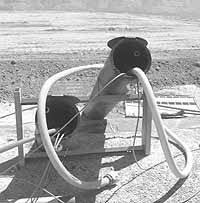| Standpipes with pumps lead to sumps which drain off accumulated moisture. |
Building a landfill that will hold up to the elements of weather and natural phenomenon is somewhat like building a house. Without a firm foundation the structure will eventually fail.
The foundation of a landfill is how the cell site is designed and built. These sites will have to safely contain materials for thousands of years, so flaws in them cannot be allowed. Each cell is lined with special liners, three in all, with soil in between them. These liners run along the walls of the cell as well as under the floor.
The bottom layer is a geotextile non-woven cushion (GCL) layer laid on top of a 5″ thick soil cushion layer. This material is impervious to water.
On top of the GCL is laid a 60 mil secondary liner, a layer of fabric drainage net and then another layer of GCL.
Then a layer of separation soil 18″ thick is laid on top of these materials. The process of laying the membranes in the exact same order is repeated on top of this level of soil.
| The non-woven Geotextile layer is only one of the three kinds of liners that is used along with soil to protect the ground water at the ECDC landfill. |
Finally the inner lining of the cell is another two feet of soil. That is the base on which the refuse is placed in layers.
Once a cell is full ( and only one MSW cell has been totally completed in the 10 year history of the landfill) it is covered with soil and the same liners in a similar way to top it off. This keeps the cell dry and ground water out.
However, the possibility of some water still leaking in exists, so a sump system has been designed so that landfill personnel can pump it out of the confines of the cell. The sump itself has even more protective layers of soil and liners to keep any water that accumulates contained in the sump. In the past 10 years, little water has accumulated in any of the sumps at the site and most of that is from moisture contained in the refuse and trash deposited.
Pumps are stationed in these sumps and can be activated by portable generators that can be moved from stand pipe site to stand pipe site. The pumps are set up with a cable so that they can be brought to the surface and replaced in case they fail.
Designed controls and testing make sure each cell site is consistent and totally contained.

